The Disparity in Canadian Indigenous Education: A Research Essay
VerifiedAdded on 2022/09/26
|7
|1708
|28
Essay
AI Summary
This research essay examines the significant educational disparities faced by the Canadian Indigenous population, focusing on the historical context of residential schools and their lasting impact. The essay argues that despite various policies and commissions aimed at achieving equitable educational opportunities, Indigenous students continue to experience discrimination and marginalization. It explores the concept of 'indigenization' in educational institutions, highlighting the need for a multifaceted approach that goes beyond mere inclusion. Drawing on sources like the 'Truth and Reconciliation Commission of Canada,' the essay discusses how historical discriminatory practices, cultural alienation, and mental health issues, such as depression and trauma, stemming from residential schools, continue to affect Indigenous students. The essay concludes by emphasizing the ongoing challenges and the need for comprehensive strategies to address the systemic inequalities within the Canadian education system.
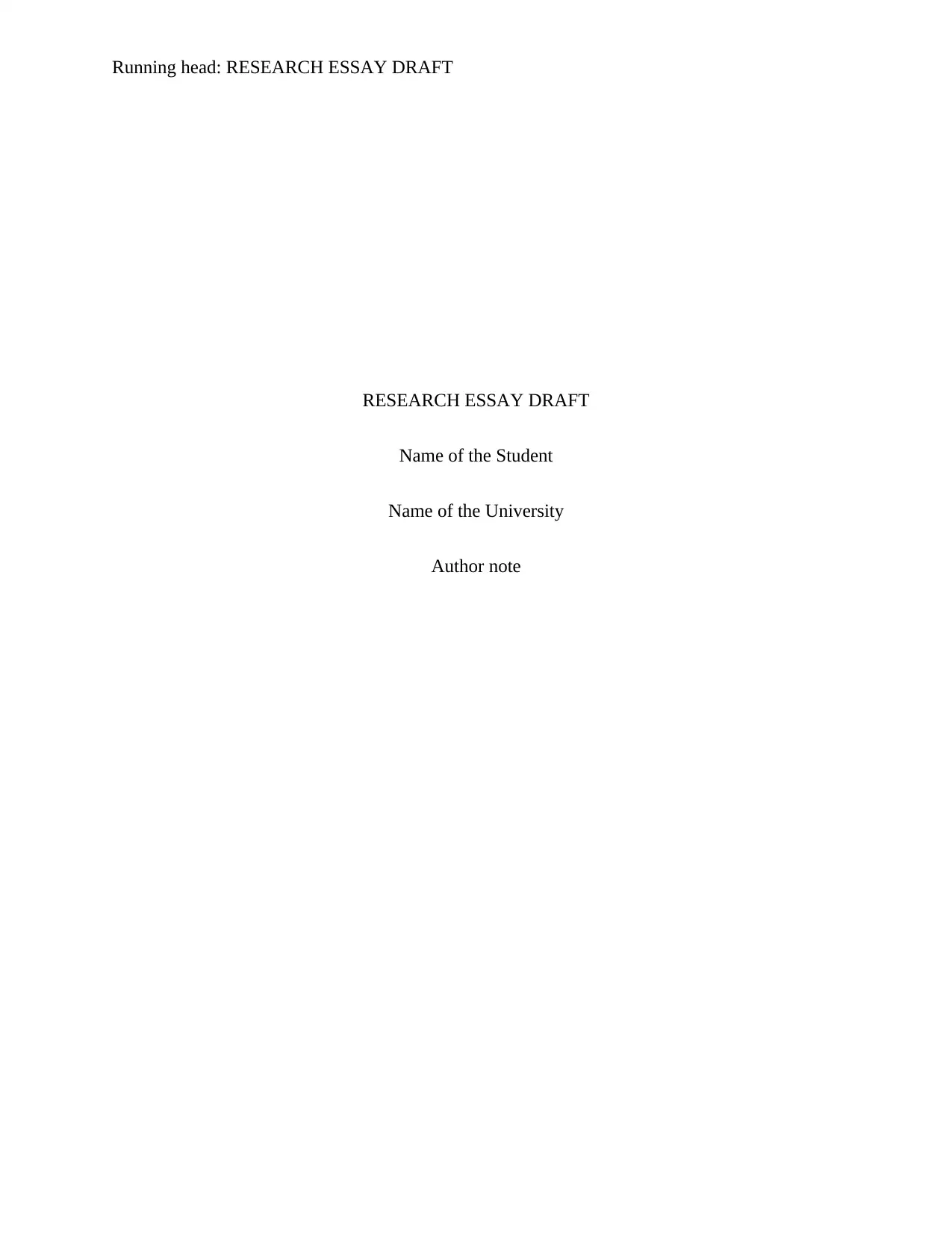
Running head: RESEARCH ESSAY DRAFT
RESEARCH ESSAY DRAFT
Name of the Student
Name of the University
Author note
RESEARCH ESSAY DRAFT
Name of the Student
Name of the University
Author note
Paraphrase This Document
Need a fresh take? Get an instant paraphrase of this document with our AI Paraphraser
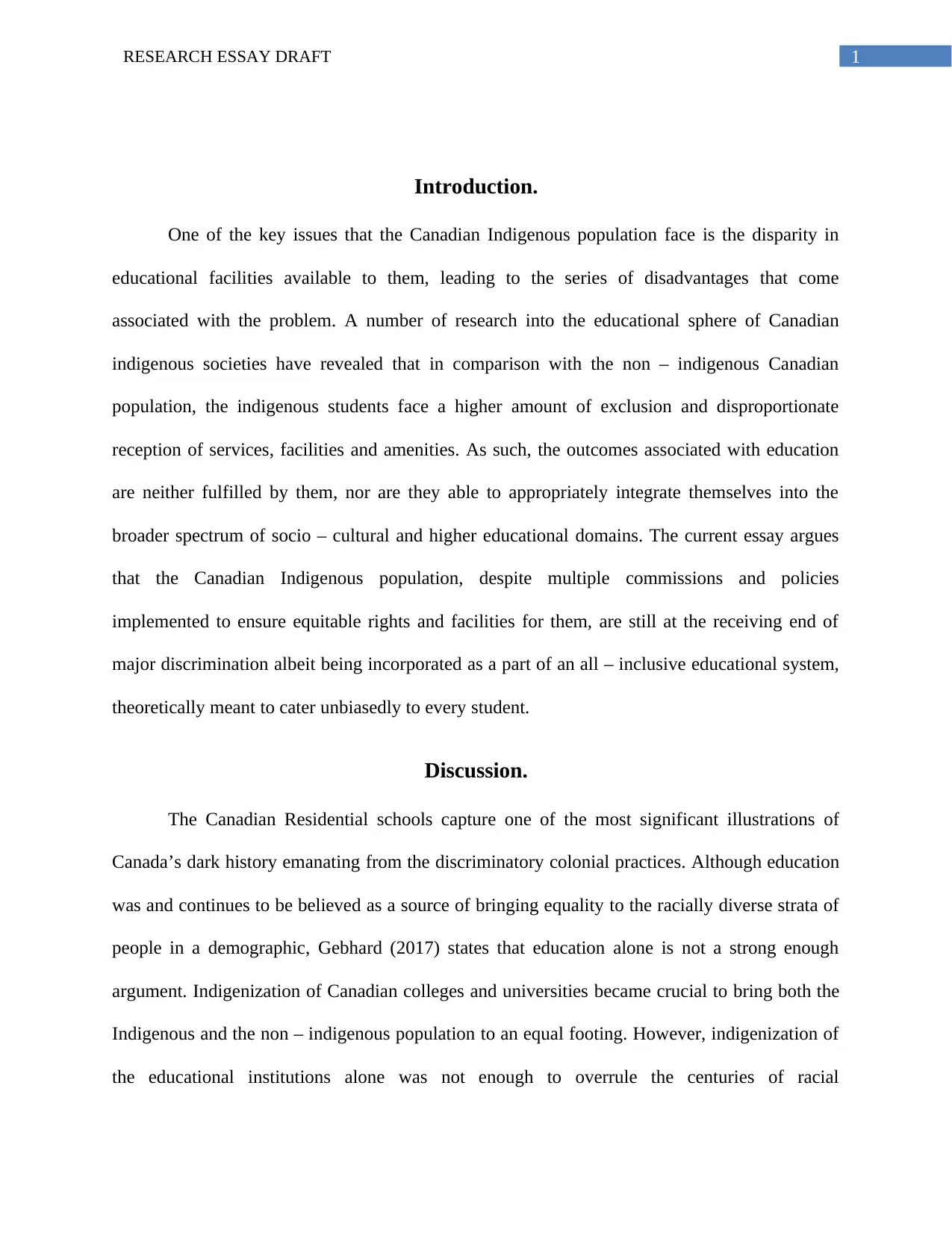
1RESEARCH ESSAY DRAFT
Introduction.
One of the key issues that the Canadian Indigenous population face is the disparity in
educational facilities available to them, leading to the series of disadvantages that come
associated with the problem. A number of research into the educational sphere of Canadian
indigenous societies have revealed that in comparison with the non – indigenous Canadian
population, the indigenous students face a higher amount of exclusion and disproportionate
reception of services, facilities and amenities. As such, the outcomes associated with education
are neither fulfilled by them, nor are they able to appropriately integrate themselves into the
broader spectrum of socio – cultural and higher educational domains. The current essay argues
that the Canadian Indigenous population, despite multiple commissions and policies
implemented to ensure equitable rights and facilities for them, are still at the receiving end of
major discrimination albeit being incorporated as a part of an all – inclusive educational system,
theoretically meant to cater unbiasedly to every student.
Discussion.
The Canadian Residential schools capture one of the most significant illustrations of
Canada’s dark history emanating from the discriminatory colonial practices. Although education
was and continues to be believed as a source of bringing equality to the racially diverse strata of
people in a demographic, Gebhard (2017) states that education alone is not a strong enough
argument. Indigenization of Canadian colleges and universities became crucial to bring both the
Indigenous and the non – indigenous population to an equal footing. However, indigenization of
the educational institutions alone was not enough to overrule the centuries of racial
Introduction.
One of the key issues that the Canadian Indigenous population face is the disparity in
educational facilities available to them, leading to the series of disadvantages that come
associated with the problem. A number of research into the educational sphere of Canadian
indigenous societies have revealed that in comparison with the non – indigenous Canadian
population, the indigenous students face a higher amount of exclusion and disproportionate
reception of services, facilities and amenities. As such, the outcomes associated with education
are neither fulfilled by them, nor are they able to appropriately integrate themselves into the
broader spectrum of socio – cultural and higher educational domains. The current essay argues
that the Canadian Indigenous population, despite multiple commissions and policies
implemented to ensure equitable rights and facilities for them, are still at the receiving end of
major discrimination albeit being incorporated as a part of an all – inclusive educational system,
theoretically meant to cater unbiasedly to every student.
Discussion.
The Canadian Residential schools capture one of the most significant illustrations of
Canada’s dark history emanating from the discriminatory colonial practices. Although education
was and continues to be believed as a source of bringing equality to the racially diverse strata of
people in a demographic, Gebhard (2017) states that education alone is not a strong enough
argument. Indigenization of Canadian colleges and universities became crucial to bring both the
Indigenous and the non – indigenous population to an equal footing. However, indigenization of
the educational institutions alone was not enough to overrule the centuries of racial
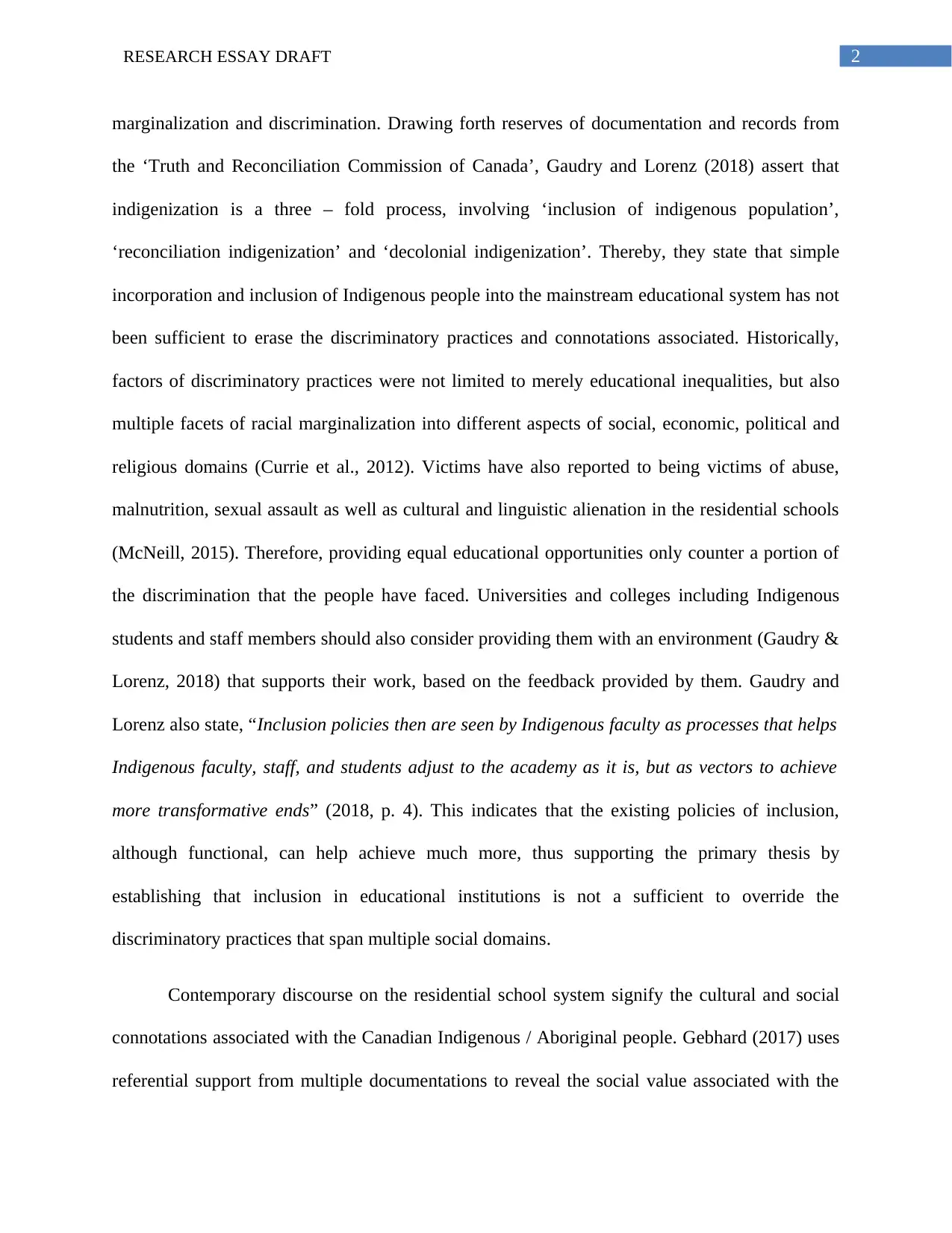
2RESEARCH ESSAY DRAFT
marginalization and discrimination. Drawing forth reserves of documentation and records from
the ‘Truth and Reconciliation Commission of Canada’, Gaudry and Lorenz (2018) assert that
indigenization is a three – fold process, involving ‘inclusion of indigenous population’,
‘reconciliation indigenization’ and ‘decolonial indigenization’. Thereby, they state that simple
incorporation and inclusion of Indigenous people into the mainstream educational system has not
been sufficient to erase the discriminatory practices and connotations associated. Historically,
factors of discriminatory practices were not limited to merely educational inequalities, but also
multiple facets of racial marginalization into different aspects of social, economic, political and
religious domains (Currie et al., 2012). Victims have also reported to being victims of abuse,
malnutrition, sexual assault as well as cultural and linguistic alienation in the residential schools
(McNeill, 2015). Therefore, providing equal educational opportunities only counter a portion of
the discrimination that the people have faced. Universities and colleges including Indigenous
students and staff members should also consider providing them with an environment (Gaudry &
Lorenz, 2018) that supports their work, based on the feedback provided by them. Gaudry and
Lorenz also state, “Inclusion policies then are seen by Indigenous faculty as processes that helps
Indigenous faculty, staff, and students adjust to the academy as it is, but as vectors to achieve
more transformative ends” (2018, p. 4). This indicates that the existing policies of inclusion,
although functional, can help achieve much more, thus supporting the primary thesis by
establishing that inclusion in educational institutions is not a sufficient to override the
discriminatory practices that span multiple social domains.
Contemporary discourse on the residential school system signify the cultural and social
connotations associated with the Canadian Indigenous / Aboriginal people. Gebhard (2017) uses
referential support from multiple documentations to reveal the social value associated with the
marginalization and discrimination. Drawing forth reserves of documentation and records from
the ‘Truth and Reconciliation Commission of Canada’, Gaudry and Lorenz (2018) assert that
indigenization is a three – fold process, involving ‘inclusion of indigenous population’,
‘reconciliation indigenization’ and ‘decolonial indigenization’. Thereby, they state that simple
incorporation and inclusion of Indigenous people into the mainstream educational system has not
been sufficient to erase the discriminatory practices and connotations associated. Historically,
factors of discriminatory practices were not limited to merely educational inequalities, but also
multiple facets of racial marginalization into different aspects of social, economic, political and
religious domains (Currie et al., 2012). Victims have also reported to being victims of abuse,
malnutrition, sexual assault as well as cultural and linguistic alienation in the residential schools
(McNeill, 2015). Therefore, providing equal educational opportunities only counter a portion of
the discrimination that the people have faced. Universities and colleges including Indigenous
students and staff members should also consider providing them with an environment (Gaudry &
Lorenz, 2018) that supports their work, based on the feedback provided by them. Gaudry and
Lorenz also state, “Inclusion policies then are seen by Indigenous faculty as processes that helps
Indigenous faculty, staff, and students adjust to the academy as it is, but as vectors to achieve
more transformative ends” (2018, p. 4). This indicates that the existing policies of inclusion,
although functional, can help achieve much more, thus supporting the primary thesis by
establishing that inclusion in educational institutions is not a sufficient to override the
discriminatory practices that span multiple social domains.
Contemporary discourse on the residential school system signify the cultural and social
connotations associated with the Canadian Indigenous / Aboriginal people. Gebhard (2017) uses
referential support from multiple documentations to reveal the social value associated with the
⊘ This is a preview!⊘
Do you want full access?
Subscribe today to unlock all pages.

Trusted by 1+ million students worldwide
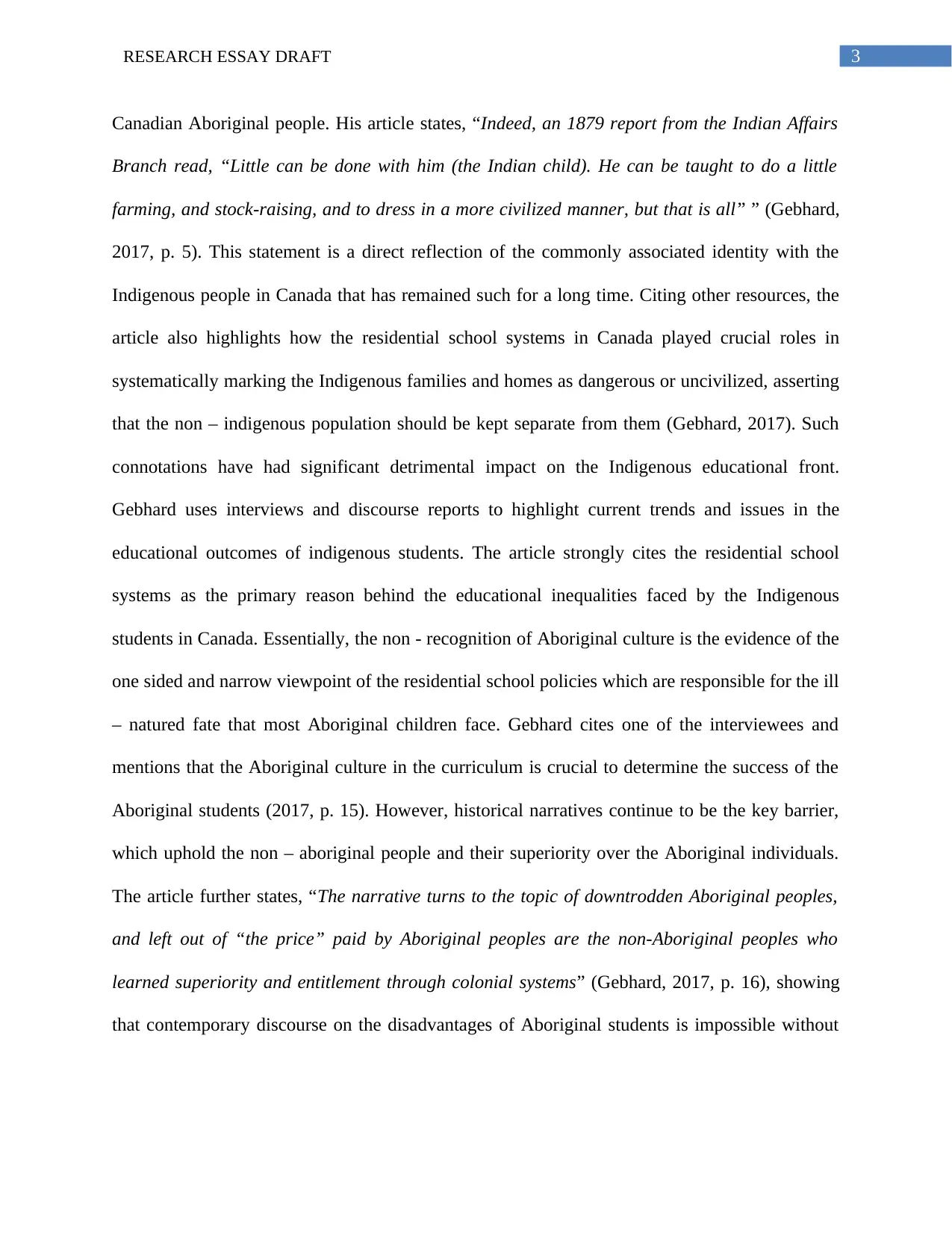
3RESEARCH ESSAY DRAFT
Canadian Aboriginal people. His article states, “Indeed, an 1879 report from the Indian Affairs
Branch read, “Little can be done with him (the Indian child). He can be taught to do a little
farming, and stock-raising, and to dress in a more civilized manner, but that is all” ” (Gebhard,
2017, p. 5). This statement is a direct reflection of the commonly associated identity with the
Indigenous people in Canada that has remained such for a long time. Citing other resources, the
article also highlights how the residential school systems in Canada played crucial roles in
systematically marking the Indigenous families and homes as dangerous or uncivilized, asserting
that the non – indigenous population should be kept separate from them (Gebhard, 2017). Such
connotations have had significant detrimental impact on the Indigenous educational front.
Gebhard uses interviews and discourse reports to highlight current trends and issues in the
educational outcomes of indigenous students. The article strongly cites the residential school
systems as the primary reason behind the educational inequalities faced by the Indigenous
students in Canada. Essentially, the non - recognition of Aboriginal culture is the evidence of the
one sided and narrow viewpoint of the residential school policies which are responsible for the ill
– natured fate that most Aboriginal children face. Gebhard cites one of the interviewees and
mentions that the Aboriginal culture in the curriculum is crucial to determine the success of the
Aboriginal students (2017, p. 15). However, historical narratives continue to be the key barrier,
which uphold the non – aboriginal people and their superiority over the Aboriginal individuals.
The article further states, “The narrative turns to the topic of downtrodden Aboriginal peoples,
and left out of “the price” paid by Aboriginal peoples are the non-Aboriginal peoples who
learned superiority and entitlement through colonial systems” (Gebhard, 2017, p. 16), showing
that contemporary discourse on the disadvantages of Aboriginal students is impossible without
Canadian Aboriginal people. His article states, “Indeed, an 1879 report from the Indian Affairs
Branch read, “Little can be done with him (the Indian child). He can be taught to do a little
farming, and stock-raising, and to dress in a more civilized manner, but that is all” ” (Gebhard,
2017, p. 5). This statement is a direct reflection of the commonly associated identity with the
Indigenous people in Canada that has remained such for a long time. Citing other resources, the
article also highlights how the residential school systems in Canada played crucial roles in
systematically marking the Indigenous families and homes as dangerous or uncivilized, asserting
that the non – indigenous population should be kept separate from them (Gebhard, 2017). Such
connotations have had significant detrimental impact on the Indigenous educational front.
Gebhard uses interviews and discourse reports to highlight current trends and issues in the
educational outcomes of indigenous students. The article strongly cites the residential school
systems as the primary reason behind the educational inequalities faced by the Indigenous
students in Canada. Essentially, the non - recognition of Aboriginal culture is the evidence of the
one sided and narrow viewpoint of the residential school policies which are responsible for the ill
– natured fate that most Aboriginal children face. Gebhard cites one of the interviewees and
mentions that the Aboriginal culture in the curriculum is crucial to determine the success of the
Aboriginal students (2017, p. 15). However, historical narratives continue to be the key barrier,
which uphold the non – aboriginal people and their superiority over the Aboriginal individuals.
The article further states, “The narrative turns to the topic of downtrodden Aboriginal peoples,
and left out of “the price” paid by Aboriginal peoples are the non-Aboriginal peoples who
learned superiority and entitlement through colonial systems” (Gebhard, 2017, p. 16), showing
that contemporary discourse on the disadvantages of Aboriginal students is impossible without
Paraphrase This Document
Need a fresh take? Get an instant paraphrase of this document with our AI Paraphraser
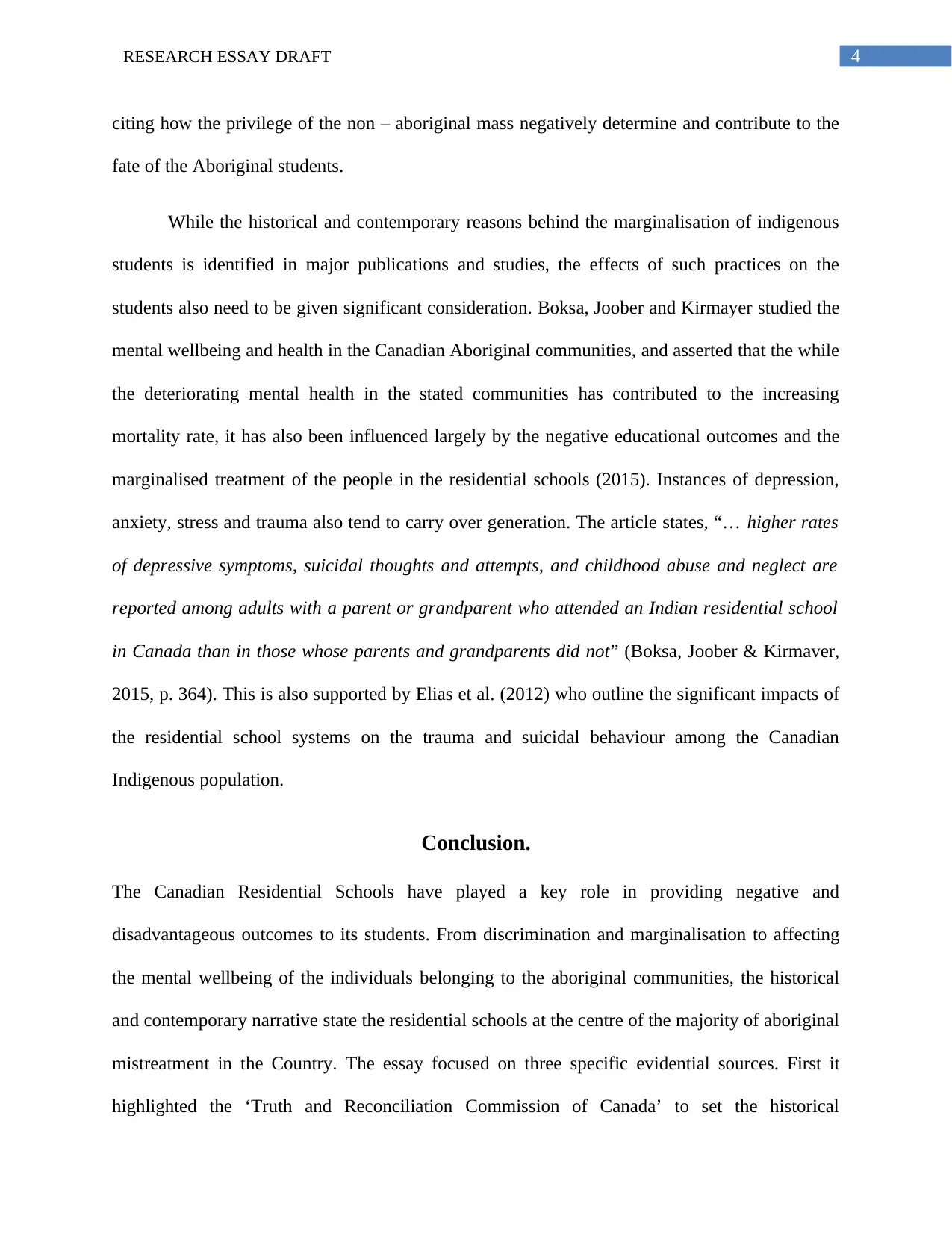
4RESEARCH ESSAY DRAFT
citing how the privilege of the non – aboriginal mass negatively determine and contribute to the
fate of the Aboriginal students.
While the historical and contemporary reasons behind the marginalisation of indigenous
students is identified in major publications and studies, the effects of such practices on the
students also need to be given significant consideration. Boksa, Joober and Kirmayer studied the
mental wellbeing and health in the Canadian Aboriginal communities, and asserted that the while
the deteriorating mental health in the stated communities has contributed to the increasing
mortality rate, it has also been influenced largely by the negative educational outcomes and the
marginalised treatment of the people in the residential schools (2015). Instances of depression,
anxiety, stress and trauma also tend to carry over generation. The article states, “… higher rates
of depressive symptoms, suicidal thoughts and attempts, and childhood abuse and neglect are
reported among adults with a parent or grandparent who attended an Indian residential school
in Canada than in those whose parents and grandparents did not” (Boksa, Joober & Kirmaver,
2015, p. 364). This is also supported by Elias et al. (2012) who outline the significant impacts of
the residential school systems on the trauma and suicidal behaviour among the Canadian
Indigenous population.
Conclusion.
The Canadian Residential Schools have played a key role in providing negative and
disadvantageous outcomes to its students. From discrimination and marginalisation to affecting
the mental wellbeing of the individuals belonging to the aboriginal communities, the historical
and contemporary narrative state the residential schools at the centre of the majority of aboriginal
mistreatment in the Country. The essay focused on three specific evidential sources. First it
highlighted the ‘Truth and Reconciliation Commission of Canada’ to set the historical
citing how the privilege of the non – aboriginal mass negatively determine and contribute to the
fate of the Aboriginal students.
While the historical and contemporary reasons behind the marginalisation of indigenous
students is identified in major publications and studies, the effects of such practices on the
students also need to be given significant consideration. Boksa, Joober and Kirmayer studied the
mental wellbeing and health in the Canadian Aboriginal communities, and asserted that the while
the deteriorating mental health in the stated communities has contributed to the increasing
mortality rate, it has also been influenced largely by the negative educational outcomes and the
marginalised treatment of the people in the residential schools (2015). Instances of depression,
anxiety, stress and trauma also tend to carry over generation. The article states, “… higher rates
of depressive symptoms, suicidal thoughts and attempts, and childhood abuse and neglect are
reported among adults with a parent or grandparent who attended an Indian residential school
in Canada than in those whose parents and grandparents did not” (Boksa, Joober & Kirmaver,
2015, p. 364). This is also supported by Elias et al. (2012) who outline the significant impacts of
the residential school systems on the trauma and suicidal behaviour among the Canadian
Indigenous population.
Conclusion.
The Canadian Residential Schools have played a key role in providing negative and
disadvantageous outcomes to its students. From discrimination and marginalisation to affecting
the mental wellbeing of the individuals belonging to the aboriginal communities, the historical
and contemporary narrative state the residential schools at the centre of the majority of aboriginal
mistreatment in the Country. The essay focused on three specific evidential sources. First it
highlighted the ‘Truth and Reconciliation Commission of Canada’ to set the historical
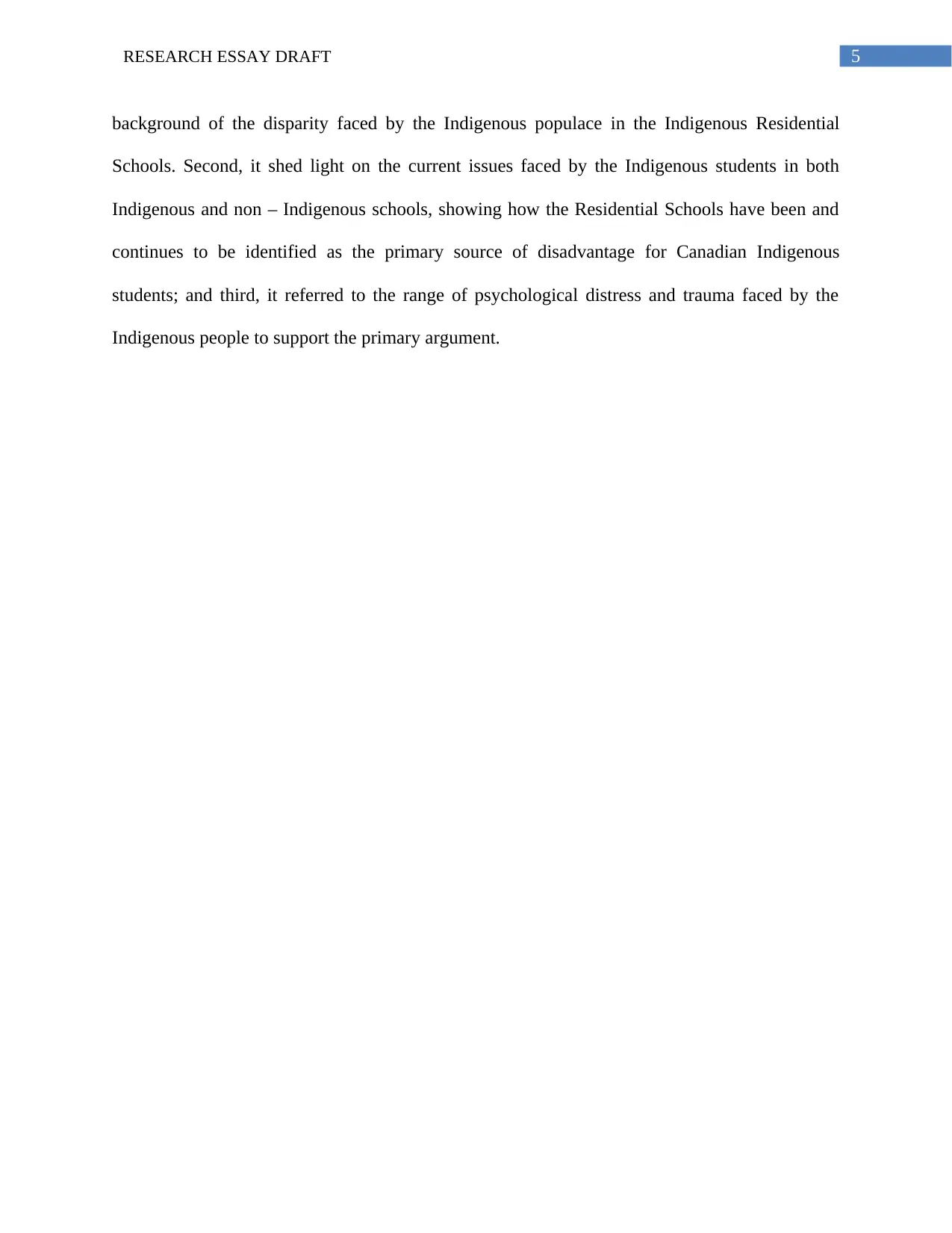
5RESEARCH ESSAY DRAFT
background of the disparity faced by the Indigenous populace in the Indigenous Residential
Schools. Second, it shed light on the current issues faced by the Indigenous students in both
Indigenous and non – Indigenous schools, showing how the Residential Schools have been and
continues to be identified as the primary source of disadvantage for Canadian Indigenous
students; and third, it referred to the range of psychological distress and trauma faced by the
Indigenous people to support the primary argument.
background of the disparity faced by the Indigenous populace in the Indigenous Residential
Schools. Second, it shed light on the current issues faced by the Indigenous students in both
Indigenous and non – Indigenous schools, showing how the Residential Schools have been and
continues to be identified as the primary source of disadvantage for Canadian Indigenous
students; and third, it referred to the range of psychological distress and trauma faced by the
Indigenous people to support the primary argument.
⊘ This is a preview!⊘
Do you want full access?
Subscribe today to unlock all pages.

Trusted by 1+ million students worldwide
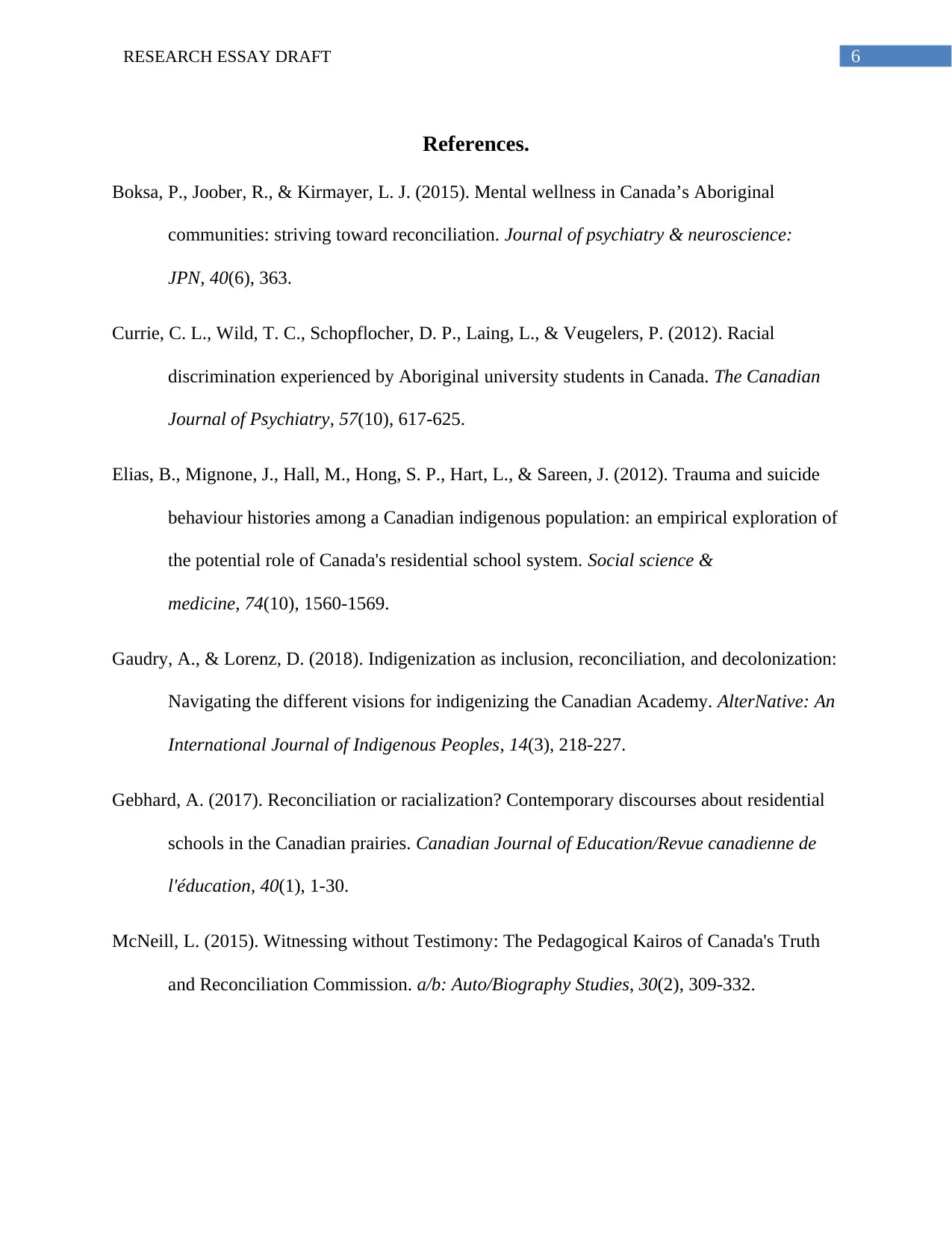
6RESEARCH ESSAY DRAFT
References.
Boksa, P., Joober, R., & Kirmayer, L. J. (2015). Mental wellness in Canada’s Aboriginal
communities: striving toward reconciliation. Journal of psychiatry & neuroscience:
JPN, 40(6), 363.
Currie, C. L., Wild, T. C., Schopflocher, D. P., Laing, L., & Veugelers, P. (2012). Racial
discrimination experienced by Aboriginal university students in Canada. The Canadian
Journal of Psychiatry, 57(10), 617-625.
Elias, B., Mignone, J., Hall, M., Hong, S. P., Hart, L., & Sareen, J. (2012). Trauma and suicide
behaviour histories among a Canadian indigenous population: an empirical exploration of
the potential role of Canada's residential school system. Social science &
medicine, 74(10), 1560-1569.
Gaudry, A., & Lorenz, D. (2018). Indigenization as inclusion, reconciliation, and decolonization:
Navigating the different visions for indigenizing the Canadian Academy. AlterNative: An
International Journal of Indigenous Peoples, 14(3), 218-227.
Gebhard, A. (2017). Reconciliation or racialization? Contemporary discourses about residential
schools in the Canadian prairies. Canadian Journal of Education/Revue canadienne de
l'éducation, 40(1), 1-30.
McNeill, L. (2015). Witnessing without Testimony: The Pedagogical Kairos of Canada's Truth
and Reconciliation Commission. a/b: Auto/Biography Studies, 30(2), 309-332.
References.
Boksa, P., Joober, R., & Kirmayer, L. J. (2015). Mental wellness in Canada’s Aboriginal
communities: striving toward reconciliation. Journal of psychiatry & neuroscience:
JPN, 40(6), 363.
Currie, C. L., Wild, T. C., Schopflocher, D. P., Laing, L., & Veugelers, P. (2012). Racial
discrimination experienced by Aboriginal university students in Canada. The Canadian
Journal of Psychiatry, 57(10), 617-625.
Elias, B., Mignone, J., Hall, M., Hong, S. P., Hart, L., & Sareen, J. (2012). Trauma and suicide
behaviour histories among a Canadian indigenous population: an empirical exploration of
the potential role of Canada's residential school system. Social science &
medicine, 74(10), 1560-1569.
Gaudry, A., & Lorenz, D. (2018). Indigenization as inclusion, reconciliation, and decolonization:
Navigating the different visions for indigenizing the Canadian Academy. AlterNative: An
International Journal of Indigenous Peoples, 14(3), 218-227.
Gebhard, A. (2017). Reconciliation or racialization? Contemporary discourses about residential
schools in the Canadian prairies. Canadian Journal of Education/Revue canadienne de
l'éducation, 40(1), 1-30.
McNeill, L. (2015). Witnessing without Testimony: The Pedagogical Kairos of Canada's Truth
and Reconciliation Commission. a/b: Auto/Biography Studies, 30(2), 309-332.
1 out of 7
Related Documents
Your All-in-One AI-Powered Toolkit for Academic Success.
+13062052269
info@desklib.com
Available 24*7 on WhatsApp / Email
![[object Object]](/_next/static/media/star-bottom.7253800d.svg)
Unlock your academic potential
Copyright © 2020–2025 A2Z Services. All Rights Reserved. Developed and managed by ZUCOL.



